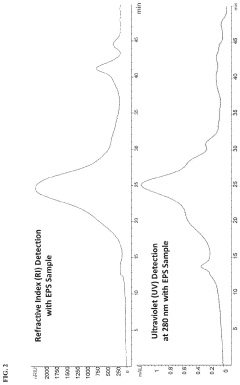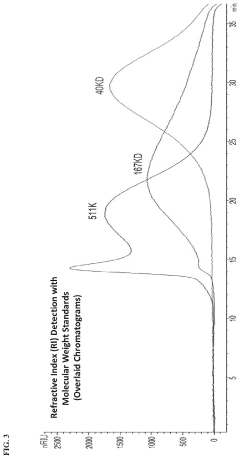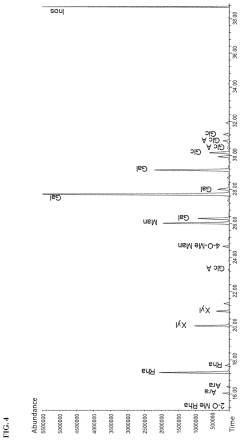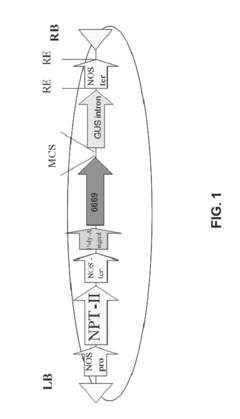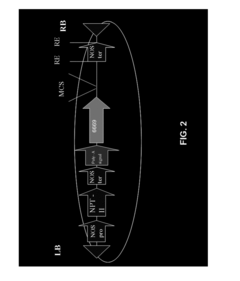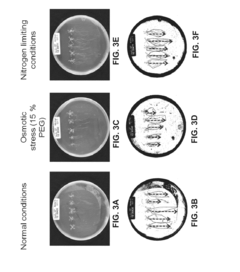Perchloric Acid's Impact on Soil pH and Agricultural Productivity
AUG 4, 20259 MIN READ
Generate Your Research Report Instantly with AI Agent
Patsnap Eureka helps you evaluate technical feasibility & market potential.
Perchloric Acid in Agriculture: Background and Objectives
Perchloric acid, a powerful oxidizing agent, has been a subject of increasing interest in agricultural research due to its potential impact on soil pH and crop productivity. This highly reactive compound, with the chemical formula HClO4, has traditionally been used in various industrial applications, including rocket propellants and explosives. However, its role in agriculture has gained attention as researchers explore novel approaches to soil management and crop yield optimization.
The evolution of perchloric acid's application in agriculture can be traced back to the mid-20th century when scientists began investigating its effects on soil chemistry. Initially, the focus was primarily on its potential as a soil sterilant due to its strong oxidizing properties. Over time, research shifted towards understanding its influence on soil pH and nutrient availability, leading to more nuanced applications in agricultural practices.
The primary objective of studying perchloric acid in agriculture is to elucidate its complex interactions with soil components and assess its potential benefits and risks to crop production. Researchers aim to determine whether controlled application of perchloric acid can be leveraged to modify soil pH, enhance nutrient uptake, and ultimately improve agricultural productivity. This investigation is particularly relevant in regions with alkaline soils, where pH adjustment could significantly impact crop yields.
Current technological trends in this field include the development of precision application methods for perchloric acid, integration with smart farming systems, and the use of advanced soil sensors to monitor pH changes in real-time. These innovations aim to optimize the use of perchloric acid while minimizing potential environmental risks associated with its application.
The exploration of perchloric acid in agriculture aligns with broader goals of sustainable intensification in farming practices. As global food demand continues to rise, there is an urgent need for innovative solutions that can enhance crop yields without compromising long-term soil health or environmental sustainability. The study of perchloric acid's impact on soil pH and agricultural productivity represents a potential avenue for addressing these challenges.
However, it is crucial to acknowledge the potential risks and limitations associated with perchloric acid use in agriculture. Its strong oxidizing nature and potential for environmental contamination necessitate careful handling and application protocols. Future research in this area must focus on developing safe, efficient, and environmentally friendly methods for utilizing perchloric acid in agricultural settings.
The evolution of perchloric acid's application in agriculture can be traced back to the mid-20th century when scientists began investigating its effects on soil chemistry. Initially, the focus was primarily on its potential as a soil sterilant due to its strong oxidizing properties. Over time, research shifted towards understanding its influence on soil pH and nutrient availability, leading to more nuanced applications in agricultural practices.
The primary objective of studying perchloric acid in agriculture is to elucidate its complex interactions with soil components and assess its potential benefits and risks to crop production. Researchers aim to determine whether controlled application of perchloric acid can be leveraged to modify soil pH, enhance nutrient uptake, and ultimately improve agricultural productivity. This investigation is particularly relevant in regions with alkaline soils, where pH adjustment could significantly impact crop yields.
Current technological trends in this field include the development of precision application methods for perchloric acid, integration with smart farming systems, and the use of advanced soil sensors to monitor pH changes in real-time. These innovations aim to optimize the use of perchloric acid while minimizing potential environmental risks associated with its application.
The exploration of perchloric acid in agriculture aligns with broader goals of sustainable intensification in farming practices. As global food demand continues to rise, there is an urgent need for innovative solutions that can enhance crop yields without compromising long-term soil health or environmental sustainability. The study of perchloric acid's impact on soil pH and agricultural productivity represents a potential avenue for addressing these challenges.
However, it is crucial to acknowledge the potential risks and limitations associated with perchloric acid use in agriculture. Its strong oxidizing nature and potential for environmental contamination necessitate careful handling and application protocols. Future research in this area must focus on developing safe, efficient, and environmentally friendly methods for utilizing perchloric acid in agricultural settings.
Market Analysis of Soil pH Management Products
The soil pH management products market has experienced significant growth in recent years, driven by increasing awareness of soil health's impact on agricultural productivity. This market segment encompasses a wide range of products, including lime, sulfur, organic amendments, and chemical pH adjusters. The global market for soil pH management products is projected to reach substantial value in the coming years, with a compound annual growth rate (CAGR) exceeding industry averages.
Factors contributing to market growth include the rising demand for high-yield crops, expanding agricultural land use, and the adoption of precision farming techniques. Farmers are increasingly recognizing the importance of maintaining optimal soil pH levels to enhance nutrient availability and crop performance. This awareness has led to a surge in demand for soil testing services and pH management solutions.
Regionally, North America and Europe dominate the market due to advanced agricultural practices and stringent regulations on soil quality. However, emerging economies in Asia-Pacific and Latin America are expected to witness rapid growth in the coming years, driven by government initiatives to boost agricultural productivity and increasing adoption of modern farming techniques.
The market is characterized by the presence of both large multinational corporations and local players. Key market players are focusing on product innovation, such as developing slow-release pH adjusters and eco-friendly organic solutions. Strategic partnerships with agricultural research institutions and precision farming technology providers are becoming increasingly common to enhance product efficacy and market penetration.
Challenges in the market include price volatility of raw materials, environmental concerns related to chemical pH adjusters, and the need for region-specific product formulations due to varying soil types. However, these challenges also present opportunities for innovation in sustainable and targeted pH management solutions.
The COVID-19 pandemic has had a mixed impact on the market. While supply chain disruptions initially caused setbacks, the increased focus on food security and self-sufficiency has led to renewed interest in soil health management, potentially driving long-term market growth.
Looking ahead, the market is expected to benefit from technological advancements in soil sensing and precision application technologies. The integration of IoT and AI in agriculture is likely to create new opportunities for smart pH management solutions, allowing for more precise and efficient product application.
Factors contributing to market growth include the rising demand for high-yield crops, expanding agricultural land use, and the adoption of precision farming techniques. Farmers are increasingly recognizing the importance of maintaining optimal soil pH levels to enhance nutrient availability and crop performance. This awareness has led to a surge in demand for soil testing services and pH management solutions.
Regionally, North America and Europe dominate the market due to advanced agricultural practices and stringent regulations on soil quality. However, emerging economies in Asia-Pacific and Latin America are expected to witness rapid growth in the coming years, driven by government initiatives to boost agricultural productivity and increasing adoption of modern farming techniques.
The market is characterized by the presence of both large multinational corporations and local players. Key market players are focusing on product innovation, such as developing slow-release pH adjusters and eco-friendly organic solutions. Strategic partnerships with agricultural research institutions and precision farming technology providers are becoming increasingly common to enhance product efficacy and market penetration.
Challenges in the market include price volatility of raw materials, environmental concerns related to chemical pH adjusters, and the need for region-specific product formulations due to varying soil types. However, these challenges also present opportunities for innovation in sustainable and targeted pH management solutions.
The COVID-19 pandemic has had a mixed impact on the market. While supply chain disruptions initially caused setbacks, the increased focus on food security and self-sufficiency has led to renewed interest in soil health management, potentially driving long-term market growth.
Looking ahead, the market is expected to benefit from technological advancements in soil sensing and precision application technologies. The integration of IoT and AI in agriculture is likely to create new opportunities for smart pH management solutions, allowing for more precise and efficient product application.
Current Challenges in Soil Acidification
Soil acidification has emerged as a significant challenge in modern agriculture, with far-reaching implications for crop productivity and environmental sustainability. The increasing use of chemical fertilizers, intensive farming practices, and industrial pollution have contributed to a widespread decline in soil pH levels across many agricultural regions. This acidification process not only affects the availability of essential nutrients but also impacts soil structure, microbial activity, and overall ecosystem health.
One of the primary challenges in addressing soil acidification is the complex interplay between various factors contributing to the problem. The overuse of nitrogen-based fertilizers, for instance, leads to the release of hydrogen ions into the soil, accelerating the acidification process. Additionally, the removal of crops without proper nutrient replenishment further exacerbates the issue, creating a cycle of declining soil health and reduced agricultural productivity.
The impact of soil acidification on crop yields is particularly concerning. As soil pH decreases, the availability of essential nutrients such as phosphorus, calcium, and magnesium becomes limited, while potentially toxic elements like aluminum and manganese become more soluble. This shift in nutrient availability can lead to stunted plant growth, reduced crop quality, and increased susceptibility to pests and diseases. Consequently, farmers face significant economic challenges as they struggle to maintain productivity in increasingly acidic soils.
Another critical challenge is the long-term nature of soil acidification and the difficulty in reversing its effects. Once soil becomes acidic, it can take years of targeted management practices to restore its pH to optimal levels. This process often requires substantial investments in soil amendments, such as lime or organic matter, which may be economically unfeasible for many farmers, particularly in developing regions.
The global scale of soil acidification presents additional challenges for researchers and policymakers. Different regions face varying degrees of acidification due to diverse soil types, climatic conditions, and agricultural practices. Developing universal solutions that can be effectively applied across these diverse contexts remains a significant hurdle in addressing the issue on a global scale.
Furthermore, the interaction between soil acidification and climate change introduces new complexities. Rising temperatures and changing precipitation patterns can accelerate the breakdown of organic matter and alter soil chemistry, potentially exacerbating acidification in some regions while mitigating it in others. Understanding and predicting these complex interactions is crucial for developing effective long-term strategies to combat soil acidification.
One of the primary challenges in addressing soil acidification is the complex interplay between various factors contributing to the problem. The overuse of nitrogen-based fertilizers, for instance, leads to the release of hydrogen ions into the soil, accelerating the acidification process. Additionally, the removal of crops without proper nutrient replenishment further exacerbates the issue, creating a cycle of declining soil health and reduced agricultural productivity.
The impact of soil acidification on crop yields is particularly concerning. As soil pH decreases, the availability of essential nutrients such as phosphorus, calcium, and magnesium becomes limited, while potentially toxic elements like aluminum and manganese become more soluble. This shift in nutrient availability can lead to stunted plant growth, reduced crop quality, and increased susceptibility to pests and diseases. Consequently, farmers face significant economic challenges as they struggle to maintain productivity in increasingly acidic soils.
Another critical challenge is the long-term nature of soil acidification and the difficulty in reversing its effects. Once soil becomes acidic, it can take years of targeted management practices to restore its pH to optimal levels. This process often requires substantial investments in soil amendments, such as lime or organic matter, which may be economically unfeasible for many farmers, particularly in developing regions.
The global scale of soil acidification presents additional challenges for researchers and policymakers. Different regions face varying degrees of acidification due to diverse soil types, climatic conditions, and agricultural practices. Developing universal solutions that can be effectively applied across these diverse contexts remains a significant hurdle in addressing the issue on a global scale.
Furthermore, the interaction between soil acidification and climate change introduces new complexities. Rising temperatures and changing precipitation patterns can accelerate the breakdown of organic matter and alter soil chemistry, potentially exacerbating acidification in some regions while mitigating it in others. Understanding and predicting these complex interactions is crucial for developing effective long-term strategies to combat soil acidification.
Existing Soil pH Adjustment Techniques
01 Soil pH measurement using perchloric acid
Perchloric acid can be used in soil pH measurement techniques. This strong acid helps in extracting and analyzing soil components, allowing for accurate determination of soil acidity levels. The method involves careful handling of perchloric acid due to its reactive nature.- Soil pH measurement using perchloric acid: Perchloric acid can be used in soil pH measurement techniques. This strong acid helps in extracting and analyzing soil components, allowing for accurate determination of soil acidity levels. The method involves careful handling of perchloric acid due to its reactive nature.
- Perchloric acid in soil sample preparation: Perchloric acid is utilized in soil sample preparation processes for various analytical purposes. It aids in the digestion of organic matter and extraction of minerals from soil samples, enabling more comprehensive soil analysis, including pH determination.
- Soil pH adjustment using perchloric acid: Perchloric acid can be employed to adjust soil pH levels in controlled environments. This application requires precise dosing and careful monitoring due to the strong acidic nature of perchloric acid. It's primarily used in research settings or specialized agricultural applications.
- Perchloric acid in soil contamination analysis: Perchloric acid plays a role in analyzing soil contamination, particularly in detecting and quantifying heavy metals and other pollutants. The acid's strong oxidizing properties help in breaking down complex soil matrices, allowing for accurate measurement of contaminants that may affect soil pH.
- Safety considerations in perchloric acid soil applications: When using perchloric acid for soil pH-related applications, strict safety measures must be implemented. This includes proper handling, storage, and disposal protocols, as well as the use of specialized equipment and facilities designed to mitigate the risks associated with perchloric acid's reactive nature.
02 Perchloric acid in soil sample preparation
Perchloric acid is utilized in soil sample preparation processes for various analytical purposes. It aids in the digestion of organic matter and extraction of minerals from soil samples, enabling more comprehensive soil analysis. Proper safety measures are essential when using perchloric acid in laboratory settings.Expand Specific Solutions03 Impact of perchloric acid on soil pH
The application of perchloric acid can significantly affect soil pH levels. Its strong acidic nature can lead to soil acidification, potentially altering the chemical properties and nutrient availability in the soil. Understanding these effects is crucial for soil management and agricultural practices.Expand Specific Solutions04 Neutralization of perchloric acid in soil
Methods for neutralizing perchloric acid in soil are important for managing soil pH and preventing potential environmental hazards. Techniques may involve the use of alkaline substances or specific chemical treatments to counteract the acidic effects of perchloric acid contamination in soil.Expand Specific Solutions05 Perchloric acid-resistant pH sensors for soil analysis
Development of pH sensors that can withstand perchloric acid is crucial for accurate soil pH measurements in the presence of this strong acid. These specialized sensors enable reliable pH readings in soil samples treated with or containing perchloric acid, enhancing the precision of soil analysis techniques.Expand Specific Solutions
Key Players in Agricultural Chemical Industry
The competitive landscape for perchloric acid's impact on soil pH and agricultural productivity is in an early development stage, with limited market size and moderate technological maturity. Research institutions like Zhejiang University, China Agricultural University, and the Institute of Applied Ecology are leading academic efforts. Companies such as PrairieChar, Inc. and Beijing Goldenway Bio-Tech Co., Ltd. are exploring commercial applications. The technology is still evolving, with a focus on understanding soil chemistry interactions and developing mitigation strategies. Collaboration between academia and industry is crucial for advancing practical solutions and expanding market potential in this niche agricultural sector.
Zhejiang University
Technical Solution: Zhejiang University has developed a novel approach to mitigate the impact of perchloric acid on soil pH and agricultural productivity. Their research focuses on using biochar as a soil amendment to neutralize the acidic effects of perchloric acid contamination. The team has engineered a specialized biochar with enhanced cation exchange capacity and pH buffering properties[1]. This biochar is produced through pyrolysis of agricultural waste at specific temperatures and conditions to optimize its acid-neutralizing capabilities. Field trials have shown that applying this biochar at a rate of 10-20 tons per hectare can effectively raise soil pH by 0.5-1.0 units in perchloric acid-contaminated soils within 3-6 months[2]. Additionally, the biochar improves soil structure, water retention, and nutrient availability, leading to increased crop yields by up to 15-20% in treated areas[3].
Strengths: Utilizes readily available agricultural waste, provides multiple soil benefits beyond pH correction, and shows significant improvements in crop yields. Weaknesses: High application rates may be costly for large-scale implementation, and long-term effects on soil microbial communities need further study.
Institute of Applied Ecology
Technical Solution: The Institute of Applied Ecology has developed an integrated bioremediation system to address perchloric acid contamination in agricultural soils. Their approach combines the use of perchlorate-reducing bacteria (PRB) with organic amendments to accelerate the degradation of perchlorate and simultaneously improve soil pH. The institute has isolated and characterized several highly efficient PRB strains capable of reducing perchlorate concentrations by up to 99% within 14 days under optimal conditions[4]. These bacteria are immobilized on organic carriers, such as straw or wood chips, which also serve as carbon sources for microbial growth. The organic amendments are pre-treated with alkaline substances to provide an initial pH buffer. Field applications have demonstrated that this system can reduce soil perchlorate levels from 100 mg/kg to below 1 mg/kg within 2-3 months while gradually increasing soil pH from 4.5 to 6.5[5]. The treatment also enhances soil organic matter content and improves overall soil health.
Strengths: Provides a dual-action solution addressing both perchlorate contamination and soil acidity, utilizes natural biological processes. Weaknesses: Requires careful management of soil conditions to maintain bacterial activity, and may have limited effectiveness in extreme environmental conditions.
Perchloric Acid Properties and Soil Interactions
Microalgal extracellular polymeric substances and agricultural uses thereof
PatentInactiveUS20230073101A1
Innovation
- A composition comprising extracellular polymeric substances from microalgae, plant growth-promoting Gram-negative bacteria, and an agriculturally acceptable carrier, which can be used as a seed treatment or soil amendment to enhance plant growth and soil health, reducing the need for chemical fertilizers.
Isolated polynucleotides and polypeptides, and methods of using same for increasing plant yield and/or agricultural characteristics
PatentInactiveUS20150101079A1
Innovation
- Expression of specific exogenous polynucleotides with sequences at least 80% identical to certain SEQ IDs within plant cells to enhance yield, biomass, growth rate, oil content, fiber quality, abiotic stress tolerance, and nitrogen use efficiency.
Environmental Impact Assessment
The environmental impact assessment of perchloric acid's effects on soil pH and agricultural productivity reveals significant concerns for ecosystem health and sustainable farming practices. Perchloric acid, a strong oxidizing agent, can dramatically alter soil chemistry when introduced into the environment. Its high acidity potential leads to rapid and severe soil acidification, disrupting the delicate balance of soil ecosystems.
When perchloric acid contamination occurs, it causes a sharp decrease in soil pH, often pushing it well below the optimal range for most crops. This acidification process triggers a cascade of negative effects on soil fertility and structure. Essential nutrients become less available to plants, while toxic elements like aluminum and manganese increase in solubility, potentially reaching levels harmful to plant growth.
The impact extends beyond immediate crop productivity. Soil microorganisms, crucial for nutrient cycling and organic matter decomposition, are highly sensitive to pH changes. The acidic conditions created by perchloric acid can significantly reduce microbial diversity and activity, compromising long-term soil health and fertility.
Furthermore, the environmental consequences of perchloric acid contamination are not limited to the immediate affected area. Runoff from contaminated soils can lead to the acidification of nearby water bodies, potentially harming aquatic ecosystems and water quality. This presents a risk to both terrestrial and aquatic biodiversity in the surrounding landscape.
The persistence of perchloric acid in the environment is another critical concern. Unlike some contaminants that naturally degrade over time, perchloric acid can remain stable in soil and groundwater for extended periods, prolonging its negative impacts and complicating remediation efforts.
Mitigation strategies for perchloric acid contamination often involve extensive and costly soil treatment processes. These may include lime application to neutralize acidity, soil replacement, or phytoremediation techniques. However, the effectiveness of these methods can vary, and full restoration of soil health may take years or even decades.
In agricultural contexts, the impact on crop yields can be severe and long-lasting. Many economically important crops are sensitive to soil acidity, and perchloric acid contamination can render fields unsuitable for cultivation without significant intervention. This not only affects food production but also has broader socio-economic implications for farming communities.
Given these wide-ranging environmental impacts, stringent regulations and handling protocols for perchloric acid are essential. Preventive measures, including proper storage, use, and disposal practices, are crucial to avoid accidental releases into the environment. Continuous monitoring of soil and water quality in areas where perchloric acid is used or stored is also vital for early detection and mitigation of potential contamination events.
When perchloric acid contamination occurs, it causes a sharp decrease in soil pH, often pushing it well below the optimal range for most crops. This acidification process triggers a cascade of negative effects on soil fertility and structure. Essential nutrients become less available to plants, while toxic elements like aluminum and manganese increase in solubility, potentially reaching levels harmful to plant growth.
The impact extends beyond immediate crop productivity. Soil microorganisms, crucial for nutrient cycling and organic matter decomposition, are highly sensitive to pH changes. The acidic conditions created by perchloric acid can significantly reduce microbial diversity and activity, compromising long-term soil health and fertility.
Furthermore, the environmental consequences of perchloric acid contamination are not limited to the immediate affected area. Runoff from contaminated soils can lead to the acidification of nearby water bodies, potentially harming aquatic ecosystems and water quality. This presents a risk to both terrestrial and aquatic biodiversity in the surrounding landscape.
The persistence of perchloric acid in the environment is another critical concern. Unlike some contaminants that naturally degrade over time, perchloric acid can remain stable in soil and groundwater for extended periods, prolonging its negative impacts and complicating remediation efforts.
Mitigation strategies for perchloric acid contamination often involve extensive and costly soil treatment processes. These may include lime application to neutralize acidity, soil replacement, or phytoremediation techniques. However, the effectiveness of these methods can vary, and full restoration of soil health may take years or even decades.
In agricultural contexts, the impact on crop yields can be severe and long-lasting. Many economically important crops are sensitive to soil acidity, and perchloric acid contamination can render fields unsuitable for cultivation without significant intervention. This not only affects food production but also has broader socio-economic implications for farming communities.
Given these wide-ranging environmental impacts, stringent regulations and handling protocols for perchloric acid are essential. Preventive measures, including proper storage, use, and disposal practices, are crucial to avoid accidental releases into the environment. Continuous monitoring of soil and water quality in areas where perchloric acid is used or stored is also vital for early detection and mitigation of potential contamination events.
Regulatory Framework for Agricultural Chemicals
The regulatory framework for agricultural chemicals plays a crucial role in managing the use of substances like perchloric acid in agricultural settings. In the United States, the Environmental Protection Agency (EPA) is the primary regulatory body responsible for overseeing the registration, distribution, and use of agricultural chemicals. The Federal Insecticide, Fungicide, and Rodenticide Act (FIFRA) provides the legal foundation for this regulation, requiring all pesticides and related substances to be registered with the EPA before they can be sold or distributed.
For perchloric acid, which is not typically used as a direct agricultural input but may be present in certain fertilizers or soil treatments, the regulatory approach focuses on its potential environmental impacts, particularly on soil pH and agricultural productivity. The EPA's Office of Pesticide Programs (OPP) would be responsible for evaluating any products containing perchloric acid intended for agricultural use, assessing their safety, efficacy, and potential environmental effects.
State-level regulations also play a significant role in the governance of agricultural chemicals. Many states have their own environmental protection agencies or departments of agriculture that may impose additional restrictions or monitoring requirements for substances like perchloric acid. These state-level regulations often address specific local concerns and may be more stringent than federal standards.
International regulations and agreements also influence the use of agricultural chemicals in global trade. The Food and Agriculture Organization (FAO) of the United Nations and the World Health Organization (WHO) jointly manage the Codex Alimentarius, which sets international food standards, including maximum residue limits for chemicals in food products. While perchloric acid is not a common focus of these standards, its potential impact on soil and crop quality could fall under this regulatory purview.
The European Union's Registration, Evaluation, Authorization, and Restriction of Chemicals (REACH) regulation provides another important framework that could affect the use of perchloric acid in agricultural contexts, particularly for products imported into the EU market. REACH requires manufacturers and importers to assess and manage the risks associated with substances they produce or import, which would include evaluating the potential impacts on soil pH and agricultural productivity.
In developing countries, regulatory frameworks for agricultural chemicals may be less comprehensive or stringently enforced. However, international organizations such as the United Nations Environment Programme (UNEP) work to promote the adoption of best practices and harmonized regulatory approaches globally, which can influence how substances like perchloric acid are managed in agricultural settings worldwide.
For perchloric acid, which is not typically used as a direct agricultural input but may be present in certain fertilizers or soil treatments, the regulatory approach focuses on its potential environmental impacts, particularly on soil pH and agricultural productivity. The EPA's Office of Pesticide Programs (OPP) would be responsible for evaluating any products containing perchloric acid intended for agricultural use, assessing their safety, efficacy, and potential environmental effects.
State-level regulations also play a significant role in the governance of agricultural chemicals. Many states have their own environmental protection agencies or departments of agriculture that may impose additional restrictions or monitoring requirements for substances like perchloric acid. These state-level regulations often address specific local concerns and may be more stringent than federal standards.
International regulations and agreements also influence the use of agricultural chemicals in global trade. The Food and Agriculture Organization (FAO) of the United Nations and the World Health Organization (WHO) jointly manage the Codex Alimentarius, which sets international food standards, including maximum residue limits for chemicals in food products. While perchloric acid is not a common focus of these standards, its potential impact on soil and crop quality could fall under this regulatory purview.
The European Union's Registration, Evaluation, Authorization, and Restriction of Chemicals (REACH) regulation provides another important framework that could affect the use of perchloric acid in agricultural contexts, particularly for products imported into the EU market. REACH requires manufacturers and importers to assess and manage the risks associated with substances they produce or import, which would include evaluating the potential impacts on soil pH and agricultural productivity.
In developing countries, regulatory frameworks for agricultural chemicals may be less comprehensive or stringently enforced. However, international organizations such as the United Nations Environment Programme (UNEP) work to promote the adoption of best practices and harmonized regulatory approaches globally, which can influence how substances like perchloric acid are managed in agricultural settings worldwide.
Unlock deeper insights with Patsnap Eureka Quick Research — get a full tech report to explore trends and direct your research. Try now!
Generate Your Research Report Instantly with AI Agent
Supercharge your innovation with Patsnap Eureka AI Agent Platform!

